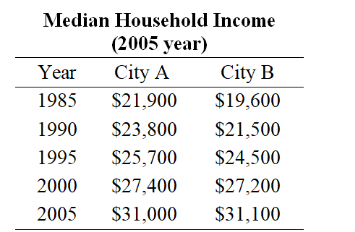The table gives the median household income (in 2005 year) for two cities in various years. Let x represent the median household income for citizens of city A and y represent the corresponding median household income for citizens of city B. Find a linear model that expresses the median household income for citizens in city B as a function of the median household income for citizens of city B. Interpret the slope of the linear model. Round numerical values in your answer to three decimal places. 
A)  slope: median household income is growing at the same rate for city A as it is for city B.
slope: median household income is growing at the same rate for city A as it is for city B.
B)  slope: median household income is growing at the same rate for city A as it is for city B.
slope: median household income is growing at the same rate for city A as it is for city B.
C)  slope: median household income is growing at the same rate for city A as it is for city B.
slope: median household income is growing at the same rate for city A as it is for city B.
D)  slope: median household income is growing faster for city A than it is for city B.
slope: median household income is growing faster for city A than it is for city B.
E)  slope: median household income is growing slower for city A than it is for city B.
slope: median household income is growing slower for city A than it is for city B.
Correct Answer:
Verified
Q96: Suppose that the cost C (in dollars)
Q97: By recognizing shapes and features of polynomial
Q98: Sketch the graph of the function
Unlock this Answer For Free Now!
View this answer and more for free by performing one of the following actions

Scan the QR code to install the App and get 2 free unlocks

Unlock quizzes for free by uploading documents